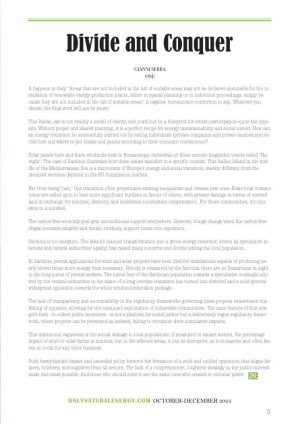 It happens in Italy. “Areas that are not included in the list of suitable areas may not be declared unsuitable for the installation of renewable energy production plants, either in spatial planning or in individual proceedings, simply because they are not included in the list of suitable areas.” A legalese bureaucratic contortion to say, ‘Whatever you decide, the final word will not be yours.’
It happens in Italy. “Areas that are not included in the list of suitable areas may not be declared unsuitable for the installation of renewable energy production plants, either in spatial planning or in individual proceedings, simply because they are not included in the list of suitable areas.” A legalese bureaucratic contortion to say, ‘Whatever you decide, the final word will not be yours.’
This Italian law is not exactly a model of clarity, and it will not be a blueprint for citizen participation—quite the opposite. Without proper and shared planning, it is a perfect recipe for energy unsustainability and social unrest. How can an energy transition be successfully carried out by letting individuals (private companies and private landowners) decide how and where to put blades and panels according to their economic convenience?
Solar panels here and there windmills next to Romanesque cathedrals or those ancient megalithic towers called “Nuraghi”. The case of Sardinia illustrates how these issues manifest in a specific context. This Italian Island in the middle of the Mediterranean Sea is a microcosm of Europe’s energy and social transition, starkly different from the idealized versions depicted in the EU Commission leaflets.
Far from being “just,” this transition often perpetuates existing inequalities and creates new ones. Some local communities are called upon to bear more significant burdens in favour of others, with greater damage in terms of scarred land in exchange for minimal, derisory, and sometimes nonexistent compensation. For those communities, it’s injustice in a nutshell.
The carbon-free economy goal gets unconditional support everywhere. However, things change when the carbon-free slogan becomes tangible and visual; suddenly, support turns into opposition.
Sardinia is no exception. The Island’s planned transformation into a green energy reservoir, driven by speculative interests and central authorities’ apathy, has raised many concerns and doubts among the local population.
In Sardinia, permit applications for wind and solar projects have been filed for installations capable of producing nearly eleven times more energy than necessary. Nobody is reassured by the fact that there are no Samaritans in sight in the long queue of permit seekers. The initial fear of the Sardinian population towards a speculative onslaught allowed by the central authorities in the name of a long overdue transition has turned into disbelief and a solid general widespread opposition towards the whole wind-and-solar-all-in package.
The lack of transparency and accountability in the regulatory frameworks governing these projects exacerbates this feeling of injustice, allowing for the continued exploitation of vulnerable communities. The main feature of this new gold rush – to collect public incentives – is not a platform for social justice but a deliberately vague regulatory framework, where projects can be presented as isolated, failing to recognize their cumulative impacts.
This intentional vagueness is the actual damage to local populations: if measured in square meters, the percentage impact of wind or solar farms is minimal, but in the affected areas, it can be disruptive, as it is massive and often leaves no room for any other business.
Such heavy-handed impact and one-sided policy fostered the formation of a solid and unified opposition that aligns farmers, hoteliers, and suppliers from all sectors. The lack of a comprehensive, long-term strategy in the public interest made this mess possible. And those who should solve it are the same ones who created it—circular power.
Gianni Serra





